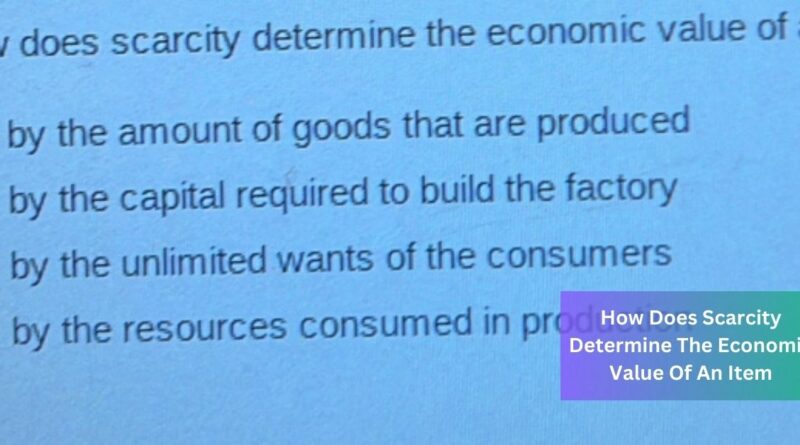How Does Scarcity Determine The Economic Value Of An Item
“Scarcity, a foundational principle in economics, significantly influences the economic worth of commodities and services.
The dynamic relationship between supply and demand, molded by scarcity, governs market prices and the distribution of resources. This article delves into the intricate ways in which scarcity shapes the economic value of an item.
Let’s explore the mechanisms that steer pricing and resource allocation, addressing the question, ‘How does scarcity determine the economic value of an item?'”
Definition of Scarcity: A Whole Understanding
Consider this scenario: there are numerous wants and needs, but the available resources are limited. Welcome to the concept of scarcity! It goes beyond having a small quantity; it’s about having less than the collective demand. Interestingly, this notion of scarcity significantly influences the economic value of various items!
1. Supply and Demand:
Imagine this scenario in the economic realm: the dynamics revolve around the intricate dance of supply and demand.
When an item becomes scarce, its desirability soars. The consequence? Prices skyrocket as everyone competes to acquire it. This follows a fundamental economic principle: the scarcer something is, the higher its price climbs!
2. Market Equilibrium:

Let’s explore the dynamics of competitive markets! Typically, prices settle at a point where demand matches supply. However, here comes the curveball – scarcity! It disrupts this equilibrium, causing prices to fluctuate.
If a product is abundant, prices may decrease. Conversely, if it’s rare, prices surge due to heightened demand. It’s as if scarcity possesses this magical ability to elevate the value of commodities!
3. Opportunity Cost:
Picture this: in a scenario where resources are scarce, individuals and businesses must strategize how to maximize the use of their limited assets.
It’s akin to solving a puzzle with only a handful of pieces! Now, here’s the intriguing part – enter the concept of opportunity cost.
Essentially, opting for one choice implies forgoing the benefits associated with another. Therefore, the value of something isn’t solely determined by its rarity but also by what you sacrifice by selecting it over alternative options!
4. Perceived Value:
Let’s discuss our perception, a significant factor in shaping the value of items. Rarity has a profound impact on our mindset.
The notion of limited availability triggers the belief that something is exclusive, exceptionally cool, and inherently more valuable.
This perception, influenced by scarcity, creates a heightened desire among individuals, resulting in a sudden surge in the economic value of the item!
5. Investment and Speculation:
Consider this scenario: scarcity possesses the magical ability to turn certain items into treasures for both investors and speculators.
Items like precious metals, rare collectibles, and limited edition goodies derive their value precisely from their elusive nature.
Investors anticipate that the rarity of these items will generate widespread demand, potentially leading to significant gains in the future.
It’s essentially a speculative game based on scarcity, completely disrupting the economic dynamics for these sought-after assets!
Read: Lisa Marie Presley Great-Grandparents – The Tapestry Of Family History!
6. Government Intervention
Alright, let’s delve into how governments act as referees in the game of scarcity management. At times, they implement regulations to control the supply of specific items, influencing their economic value.
Imagine this: quotas, tariffs, and trade restrictions are the tools wielded by governments. With these tools, they can adjust the scarcity of certain goods, directly impacting market prices!
How Does Scarcity Determine The Economic Value Of An Item?

Picture yourself in a massive candy store, but here’s the twist – there’s a limited supply of your favorite candy, and everyone in the vicinity is yearning for it too. This situation precisely encapsulates the concept of scarcity in economics.
So, What’s Scarcity?
It’s essentially when something you desire is limited compared to the demand for it. Consider the scenario of getting hold of an exceptionally rare video game – if there are only a few copies, and everyone wants one, its value increases.
Scarcity manifests in everyday life as well. Take diamonds, for instance. They’re nature’s exquisite gems, formed deep within the Earth under extraordinary conditions. Due to their rarity, they attain significant value.
While people often say diamonds are a girl’s best friend, economics asserts that they’re also a wallet’s best friend.
Now, let’s delve into the dynamic duo of economics: supply and demand. When something is scarce, and there’s a buzz around it, the price surges. Imagine being at a concert with only a handful of VIP tickets left. As everyone clamors for them, the price rises due to their scarcity and high demand.
On the contrary, think about something easily accessible everywhere, like water. In many places, it’s abundant, so it doesn’t cost much. But envision being in a desert where water is as rare as a shooting star – suddenly, that water becomes exceptionally valuable.
Scarcity isn’t solely about goods; it also influences prices. When something becomes scarce, sellers can increase prices. Consider the scenario before a storm hits, and everyone rushes to stock up on essentials like food and water. Since everyone’s grabbing items, prices rise because there’s not enough to meet the demand.
So, the next time you eye the last piece of your favorite candy or dream of a shiny diamond, remember that scarcity is what adds extra significance to them in the realm of economics!
Read: Welby Login – You Need To Know!
1. Key Takeaways:
Scarcity indicates a shortage of something essential. It occurs when the desired item is limited compared to the overall demand. Picture a candy store with a restricted supply of your favorite candy – everyone desires it, but there isn’t enough for everyone.
Diamonds, formed under extreme conditions within the Earth, are rare, making them highly valuable in economics. When something is scarce and in high demand, its price rises. Consider VIP concert tickets – if only a few remain, the price escalates due to overwhelming demand.
Easily accessible items, like water in many places, remain affordable because they aren’t scarce. However, in a desert where water is rare, its value increases.
Scarcity directly influences prices; when something is rare, sellers can charge more. During emergencies, such as a storm, essential prices surge due to sudden scarcity caused by heightened demand.
Scarcity extends beyond physical items; it’s also about the value they acquire when they’re challenging to find. The next time you eye the last piece of your favorite candy or dream of a dazzling diamond, remember that scarcity adds a special dimension to them in the realm of economics!
To Conclude
In summary, scarcity plays a pivotal role in shaping the economic value of an item. The intricate interplay of supply and demand, opportunity cost, perceived value, investment dynamics, and government interventions collectively contribute to the nuanced relationship between scarcity and economic value.
A comprehensive understanding of these factors is crucial for grasping market dynamics and making well-informed decisions regarding resource allocation. This knowledge is vital for exploring the question of “How does scarcity determine the economic value of an item?”
Read:

